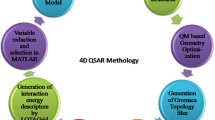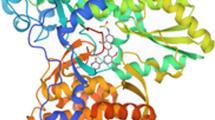ABSTRACT
Purpose
To predict and determine whether the protease inhibitors (PIs) nelfinavir, amprenavir, atazanavir, ritonavir, and saquinavir could serve as metabolic inhibitors of the human CES1 (hCES1) using both molecular modeling techniques and in vitro inhibition assays.
Methods
Initially, a molecular modeling approach was utilized to predict whether the selected PIs could serve as hCES1 inhibitors. The inhibitory effects of these PIs on hCES1 activity were then further evaluated utilizing previously established in vitro assay.
Results
Pharmacophore and 2D-QSAR modeling predicted that nelfinavir would serve as a potent hCES1 inhibitor. This hypothesis was validated by in vitro hCES1 inhibition studies. Other PIs (amprenavir, atazanavir, ritonavir, saquinavir) were evaluated and also shown to be hCES1 inhibitors in vitro, although substantially less potent relative to nelfinavir.
Conclusion
Computational molecular modeling is a valid approach to identify potential hCES1 inhibitors as candidates for further assessment using validated in vitro techniques. DDIs could occur when nelfinavir is co-administered with drugs metabolized by hCES1.









Similar content being viewed by others
REFERENCES
Volberdingand PA, Deeks SG. Antiretroviral therapy and management of HIV infection. Lancet. 2010;376:49–62.
Thompson MA, Aberg JA, Cahn P, Montaner JS, Rizzardini G, Telenti A, Gatell JM, Gunthard HF, Hammer SM, Hirsch MS, Jacobsen DM, Reiss P, Richman DD, Volberding PA, Yeni P, Schooley RT. Antiretroviral treatment of adult HIV infection: 2010 recommendations of the International AIDS Society-USA panel. JAMA. 2010;304:321–33.
Marzolini C, Elzi L, Gibbons S, Weber R, Fux C, Furrer H, Chave JP, Cavassini M, Bernasconi E, Calmy A, Vernazza P, Khoo S, Ledergerber B, Back D, Battegay M. Prevalence of comedications and effect of potential drug-drug interactions in the Swiss HIV Cohort Study. Antivir Ther. 2010;15:413–23.
Hawkins T. Understanding and managing the adverse effects of antiretroviral therapy. Antiviral Res. 2010;85:201–9.
Pauand AK, Boyd SD. Recognition and management of significant drug interactions in HIV patients: challenges in using available data to guide therapy. Clin Pharmacol Ther. 2010;88:712–9.
Kis O, Robillard K, Chan GN, Bendayan R. The complexities of antiretroviral drug-drug interactions: role of ABC and SLC transporters. Trends Pharmacol Sci. 2010;31:22–35.
AIDSinfo. Guidelines for the Use of Antiretroviral Agents in HIV-1-Infected Adults and Adolescents. http://aidsinfonihgov/Guidelines/GuidelineDetailaspx?GuidelineID=7&ClassID=1 (2011).
Grimm SW, Einolf HJ, Hall SD, He K, Lim HK, Ling KH, Lu C, Nomeir AA, Seibert E, Skordos KW, Tonn GR, Van Horn R, Wang RW, Wong YN, Yang TJ, Obach RS. The conduct of in vitro studies to address time-dependent inhibition of drug-metabolizing enzymes: a perspective of the pharmaceutical research and manufacturers of America. Drug Metab Dispos. 2009;37:1355–70.
Imai T, Taketani M, Shii M, Hosokawa M, Chiba K. Substrate specificity of carboxylesterase isozymes and their contribution to hydrolase activity in human liver and small intestine. Drug Metab Dispos. 2006;34:1734–41.
Satoh T, Taylor P, Bosron WF, Sanghani SP, Hosokawa M, La Du BN. Current progress on esterases: from molecular structure to function. Drug Metab Dispos. 2002;30:488–93.
Fleming CD, Bencharit S, Edwards CC, Hyatt JL, Tsurkan L, Bai F, Fraga C, Morton CL, Howard-Williams EL, Potter PM, Redinbo MR. Structural insights into drug processing by human carboxylesterase 1: tamoxifen, mevastatin, and inhibition by benzil. J Mol Biol. 2005;352:165–77.
Bencharit S, Morton CL, Xue Y, Potter PM, Redinbo MR. Structural basis of heroin and cocaine metabolism by a promiscuous human drug-processing enzyme. Nat Struct Biol. 2003;10:349–56.
Zhu HJ, Appel DI, Peterson YK, Wang Z, Markowitz JS. Identification of selected therapeutic agents as inhibitors of carboxylesterase 1: potential sources of metabolic drug interactions. Toxicology. 2010;270:59–65.
Zhu HJ, Patrick KS, Yuan HJ, Wang JS, Donovan JL, DeVane CL, Malcolm R, Johnson JA, Youngblood GL, Sweet DH, Langaee TY, Markowitz JS. Two CES1 gene mutations lead to dysfunctional carboxylesterase 1 activity in man: clinical significance and molecular basis. Am J Hum Genet. 2008;82:1241–8.
Hatfield MJ, Tsurkan L, Hyatt JL, Yu X, Edwards CC, Hicks LD, Wadkins RM, Potter PM. Biochemical and molecular analysis of carboxylesterase-mediated hydrolysis of cocaine and heroin. Br J Pharmacol. 2010;160:1916–28.
Zhu HJ, Markowitz JS. Activation of the antiviral prodrug oseltamivir is impaired by two newly identified carboxylesterase 1 variants. Drug Metab Dispos. 2009;37:264–7.
Nagao Y, Ishitobi Y, Kinoshita H, Fukushima S, Kawashima H. YM175, a new bisphosphonate, increases serum 1,25-dihydroxyvitamin D in rats via stimulating renal 1-hydroxylase activity. Biochem Biophys Res Commun. 1991;180:1172–8.
Vistoli G, Pedretti A, Mazzolari A, Testa B. In silico prediction of human carboxylesterase-1 (hCES1) metabolism combining docking analyses and MD simulations. Bioorg Med Chem. 2010;18:320–9.
Zhu HJ, Appel DI, Jiang Y, Markowitz JS. Age- and sex-related expression and activity of carboxylesterase 1 and 2 in mouse and human liver. Drug Metab Dispos. 2009;37:1819–25.
Takahashi S, Katoh M, Saitoh T, Nakajima M, Yokoi T. Different inhibitory effects in rat and human carboxylesterases. Drug Metab Dispos. 2009;37:956–61.
Liu R, Tam TW, Mao J, Saleem A, Krantis A, Arnason JT, Foster BC. The effect of natural health products and traditional medicines on the activity of human hepatic microsomal-mediated metabolism of oseltamivir. J Pharm Pharm Sci. 2010;13:43–55.
Hirt D, Mentre F, Tran A, Rey E, Auleley S, Salmon D, Duval X, Treluyer JM. Effect of CYP2C19 polymorphism on nelfinavir to M8 biotransformation in HIV patients. Br J Clin Pharmacol. 2008;65:548–57.
Read JS, Best BM, Stek AM, Hu C, Capparelli EV, Holland DT, Burchett SK, Smith ME, Sheeran EC, Shearer WT, Febo I, Mirochnick M. Pharmacokinetics of new 625 mg nelfinavir formulation during pregnancy and postpartum. HIV Med. 2008;9:875–82.
Fichtenbaum CJ, Gerber JG, Rosenkranz SL, Segal Y, Aberg JA, Blaschke T, Alston B, Fang F, Kosel B, Aweeka F. Pharmacokinetic interactions between protease inhibitors and statins in HIV seronegative volunteers: ACTG Study A5047. AIDS. 2002;16:569–77.
Hsyu PH, Schultz-Smith MD, Lillibridge JH, Lewis RH, Kerr BM. Pharmacokinetic interactions between nelfinavir and 3-hydroxy-3-methylglutaryl coenzyme A reductase inhibitors atorvastatin and simvastatin. Antimicrob Agents Chemother. 2001;45:3445–50.
Hare CB, Vu MP, Grunfeld C, Lampiris HW. Simvastatin-nelfinavir interaction implicated in rhabdomyolysis and death. Clin Infect Dis. 2002;35:e111–2.
Wei E, Ben Ali Y, Lyon J, Wang H, Nelson R, Dolinsky VW, Dyck JR, Mitchell G, Korbutt GS, Lehner R. Loss of TGH/Ces3 in mice decreases blood lipids, improves glucose tolerance, and increases energy expenditure. Cell Metab. 2010;11:183–93.
Author information
Authors and Affiliations
Corresponding author
Electronic supplementary material
Below is the link to the electronic supplementary material.
Supplemental Table 1
Table of the activists and physiochemical properties of hCES1 inhibitors. Compounds are ordered according to highest activity in pIC50. (DOCX 115 kb)
Supplemental Table 2
Comparison of the relative importance of the top 20 descriptors for hCES1 2D QSAR models. The importance of weight might lie in that the active site pocket has limited volume, excluding compounds above a given mass. (DOCX 70.4 kb)
Rights and permissions
About this article
Cite this article
Rhoades, J.A., Peterson, Y.K., Zhu, HJ. et al. Prediction and In Vitro Evaluation of Selected Protease Inhibitor Antiviral Drugs as Inhibitors of Carboxylesterase 1: A Potential Source of Drug-Drug Interactions. Pharm Res 29, 972–982 (2012). https://doi.org/10.1007/s11095-011-0637-9
Received:
Accepted:
Published:
Issue Date:
DOI: https://doi.org/10.1007/s11095-011-0637-9




